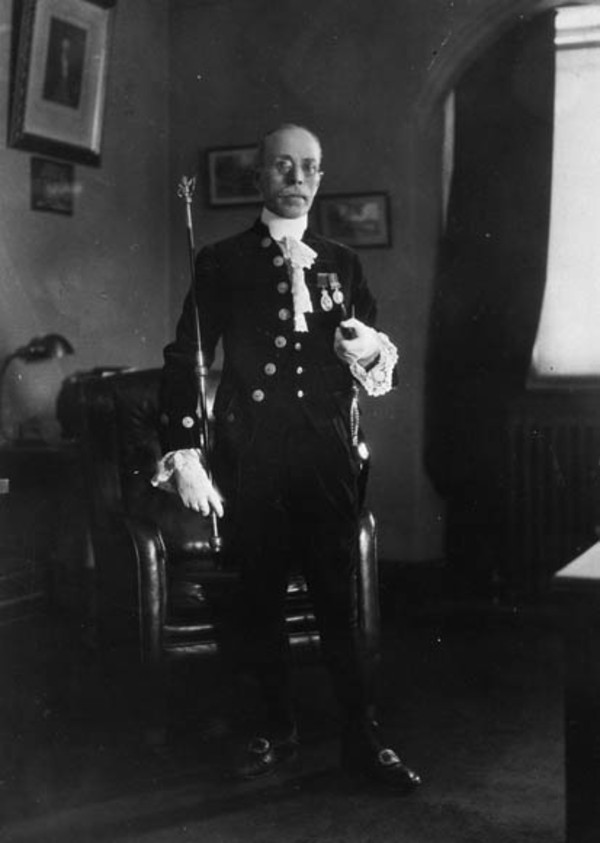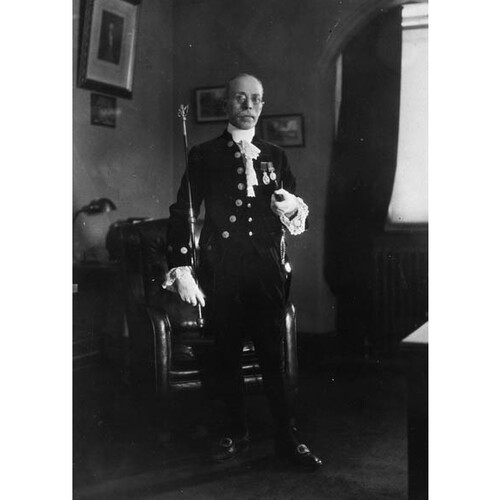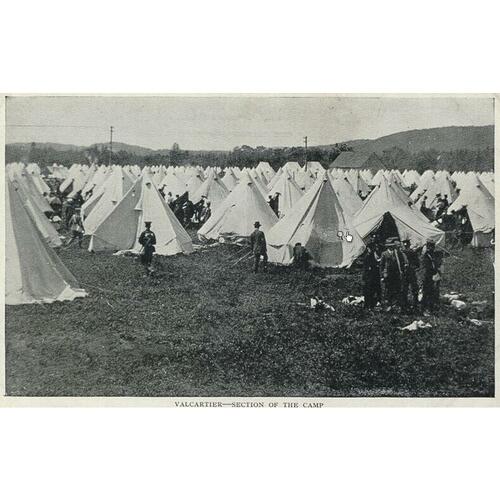CHAMBERS, ERNEST JOHN, militia officer, journalist, author, and civil servant; b. 16 April 1862 in Penkridge, England, youngest son of Edward Thomas Chambers and Louisa Percy Davies; m. 31 Aug. 1898 Bertha Macmillan of Kingston, Ont., and they had a son and a daughter; d. 11 May 1925 in Vaudreuil, Que.
Ernest J. Chambers attended grammar school in Penkridge, and in 1870 the family immigrated to Canada, where his father would become headmaster of the British and Canadian School in Montreal. Chambers continued his education at the Prince Albert School in Saint-Henri-des-Tanneries (Montreal) and then at the High School of Montreal. During his youth he displayed an affinity for the militia: he progressed quickly to a captaincy in the Montreal High School Cadet Rifles and during the 1880s he was an officer in the 6th Battalion of Infantry (Fusiliers).
Like his brother Edward Thomas Davies, Chambers became a journalist. As a field correspondent for the Montreal Daily Star, he journeyed west in 1885 to cover Major-General Frederick Dobson Middleton*’s drive to suppress the Métis uprising. He was a volunteer galloper at the battles of Fish Creek and Batoche (Sask.), and contributed to the operations against Big Bear [Mistahimaskwa*], for which efforts he was decorated. In 1888-89 he was managing editor and publisher of the Calgary Herald.
He subsequently returned to Montreal, where in 1893-96 he was joint proprietor and editor of the Canadian Military Gazette. The degree to which militarist and imperialist interests guided Chambers, who had resumed service with the 6th Battalion, is evident from the regimental histories he began producing in 1897. In the Origin and services of the 3rd (Montreal) Field Battery of Artillery (Montreal, 1898), for example, he portrayed a unit that was proud to display its “determination to keep the Union Jack flying for all time over this broad Dominion.” On the militia’s formation in April 1903 of an intelligence corps, the Corps of Guides, Chambers became a captain and intelligence officer for Military District No.5 (Montreal and southwest Quebec). Chambers was also prominent in Montreal’s musical circles. Associated with the Montreal Amateur Operatic Club and the choir of Christ Church Cathedral, in 1901 he had been appointed honorary secretary in Canada of two British bodies, the Royal Academy of Music and the Royal College of Music.
Chambers left Montreal for Ottawa as a result of his prestigious appointment on 1 March 1904 as gentleman usher of the Black Rod, a functionary in the Senate. His official presence increased four years later when he took on the editorship of the Canadian parliamentary guide. As well, in 1912 he became secretary of the Canadian branch of the Empire Parliamentary Association. On moving to Ottawa, Chambers had brought with him his attachment to the Corps of Guides, in which he was promoted major (1911), lieutenant-colonel (1915), and colonel (1917).
Following the eruption of World War I in 1914, the government had initiated the surveillance of international cable and wireless transmissions. In addition to his parliamentary duties, Chambers worked as a censor at military headquarters. Given his journalistic experience, he was occasionally called upon to speak to the press. Within a year, leakages of sensitive information forced the cabinet to tighten control: on 10 June 1915 the office of chief press censor was created by an order in council under the War Measures Act. Possessed of superb interpersonal skills, extensive contacts in the news world, and solid militia and imperial credentials, Chambers was named to the post, with authority to block any source criticizing military policy, promoting disaffection, aiding the enemy, or otherwise “hindering the successful prosecution of the war.” To encourage cooperation he initially had instructions distributed widely to publishers, police services, government officials across Canada, and any party likely to handle information on the war.
Chambers proved untiring and unyielding in his efforts to shelter citizens from printed material that might compromise their commitment to the war, including accurate news of the gruesome realities of trench warfare. If newspapers wanted to print soldiers’ correspondence, he insisted that unsullied images be conveyed. Some editors, such as Frederick William Field of the Monetary Times (Toronto), took the precaution of having Chambers screen letters. Heartily endorsed by the chief censor were innocuous selections such as “the trenches were not so bad,” but when it came to one private’s claim that “the man who said war was hell did not know anything about it, for it [was] far worse,” he insisted that the scissors be applied. Regulations introduced between 1915 and 1918 gave him considerable discretion too in shaping the content of publicly viewed photographs and movies, theatrical productions, gramophone recordings, and even sheet music.
During his tenure, working usually with great tact, sometimes with heavy-handedness, Chambers banned 253 tracts; of these 222 came from the United States, 164 appeared in a language other than French or English, and 93 espoused leftist philosophy. In his bans and surveillance, he reflected and reinforced intolerance of pacifism, official antipathy towards socialism, and strong nativist tendencies. At the outset of the war, Chambers had wanted to move forcefully against the foreign-language press, but his powers then were limited and his political masters were cautious. He did try several times to restrain criticism of the war by Henri Bourassa*’s Le Devoir (Montréal) but Prime Minister Sir Robert Laird Borden* intervened each time, fearing backlash. Chambers’s powers nevertheless mounted steadily. An order in council in September 1918 allowed him to close down all publications in an “enemy language.” Subsequent amendments extended his mandate to targets that had nothing to do with war. In the aftermath of the Winnipeg General Strike in 1919, for instance, the Yiddish Volkstimme, which had supported the strikers, was banned.
The position of chief press censor was dissolved at the end of 1919. Chambers, who transferred to the Guides’ reserve list in April 1920, nonetheless continued to wage battle against those he perceived as enemies. He served, for instance, as an informal adviser to the Royal Canadian Mounted Police on “dangerous” left-wing tendencies in such publications as the British Columbia Federationist (Vancouver) and the Searchlight (Calgary).
When not tied to parliamentary duties, Chambers spent much of his time enjoying his favourite recreations in the Ottawa area and in Quebec: golf, yachting, shooting, and fishing. He edited the Canadian parliamentary guide and served as Black Rod until his death at his summer home in Vaudreuil, after a short pulmonary illness. An Anglican, he was buried in Mount Royal Cemetery in Outremont (Montreal). Eulogies and obituaries focused less on his draconian achievements as a wartime censor and more on his literary output and service on Parliament Hill. As the Ottawa Evening Journal noted, “He fitted into Parliamentary ritual and symbolism with an appropriateness that none could excel.”
Publications by Ernest John Chambers include The Montreal Highland Cadets; being a record of the organization and development of a useful and interesting corps, with some notes on the cadet movements in Britain and Canada (Montreal, 1901); The Queen’s Own Rifles of Canada; a history of a splendid regiment’s origin, development and services . . . (Toronto, 1901); The Governor-General’s Body Guard, a history of the origin, development and services of the senior cavalry regiment in the militia service of the Dominion of Canada . . . (Toronto, 1902); “The Duke of Cornwall’s Own Rifles”; a regimental history of the Forty-Third Regiment, active militia of Canada (Ottawa, 1903); The 5th Regiment, Royal Scots of Canada Highlanders; a regimental history (Montreal, 1904); The book of Canada; illustrating the great dominion . . . (Montreal, [1905]); The Royal North-West Mounted Police: a corps history (Montreal, 1906); and The Canadian militia; a history of the origin and development of the force (Montreal, [1907]).
NA, MG 26, H; RG 6, E1. Ottawa Evening Journal, 12–13, 15 May 1925. W. A. Bausenhart, “The Ontario German language press and its suppression by order-in-council in 1918,” Canadian Ethnic Studies (Calgary), 4 (1972), no.1/2: 35–48. Can., Dept. of Militia and Defence, Militia list (Ottawa), 1903–20. Canadian annual rev., 1903: 412. Canadian men and women of the time (Morgan; 1912). CPG, 1905: 39; 1918: 87. Canadian who’s who (1910). Cyclopædia of Canadian biog. (Rose and Charlesworth), vol.3. W. Entz, “The suppression of the German language press in September 1918 (with special reference to the secular German language papers in western Canada),” Canadian Ethnic Studies, 8 (1976), no.2: 56–70. G. S. Kealey, “The early years of state surveillance of labour and the left in Canada: the institutional framework of the Royal Canadian Mounted Police security and intelligence apparatus, 1918–26,” in Espionage: past, present and future? ed. W. K. Wark (London, 1994), 129–48; “State repression of labour and the left in Canada, 1914–20: the impact of the First World War,” CHR, 73 (1992): 281–314. J. A. Keshen, Propaganda and censorship during Canada’s Great War (Edmonton, 1996). Arja Pilli, The Finnish-language press in Canada, 1901–1939: a study in the history of ethnic journalism (Helsinki, 1982). Who’s who and why, 1919–20. Who’s who in Canada, 1922.
Cite This Article
Jeffrey A. Keshen, “CHAMBERS, ERNEST JOHN,” in Dictionary of Canadian Biography, vol. 15, University of Toronto/Université Laval, 2003–, accessed January 9, 2026, https://www.biographi.ca/en/bio/chambers_ernest_john_15E.html.
The citation above shows the format for footnotes and endnotes according to the Chicago manual of style (16th edition). Information to be used in other citation formats:
| Permalink: | https://www.biographi.ca/en/bio/chambers_ernest_john_15E.html |
| Author of Article: | Jeffrey A. Keshen |
| Title of Article: | CHAMBERS, ERNEST JOHN |
| Publication Name: | Dictionary of Canadian Biography, vol. 15 |
| Publisher: | University of Toronto/Université Laval |
| Year of publication: | 2005 |
| Year of revision: | 2005 |
| Access Date: | January 9, 2026 |





